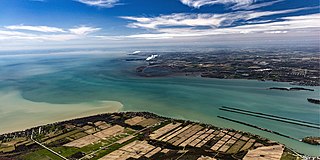
The Detroit River is an international river in North America. The river, which forms part of the border between the U.S. state of Michigan and the Canadian province of Ontario, flows west and south for 24 nautical miles from Lake St. Clair to Lake Erie as a strait in the Great Lakes system. The river divides the metropolitan areas of Detroit, Michigan, and Windsor, Ontario—an area collectively referred to as Detroit–Windsor. The Ambassador Bridge, the Detroit–Windsor Tunnel, and the Michigan Central Railway Tunnel connect the cities.

Wayne County is the most populous county in the U.S. state of Michigan. As of 2020, the United States census placed its population at 1,793,561, making it the 19th-most populous county in the United States. The county seat is Detroit. The county was founded in 1796 and organized in 1815. Wayne County is included in the Detroit-Warren-Dearborn, MI Metropolitan Statistical Area. It is one of several U.S. counties named after Revolutionary War-era general Anthony Wayne.
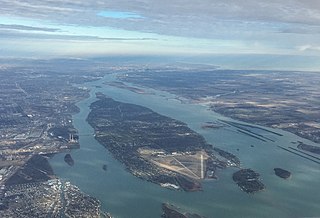
Grosse Ile Township is a civil township of Wayne County in the U.S. state of Michigan. The population was 10,777 at the 2020 census.

Trenton is a city in Wayne County, Michigan, United States. At the 2010 census, the city population was 18,853.
Jefferson Avenue is a 63.71-mile-long (102.53 km) scenic road along the eastern part of the Detroit metropolitan area in the southeastern part of the U.S. state of Michigan. It travels alongside Lake Erie, the Detroit River, and Lake St. Clair. This road also provides access to many recreational facilities in the area. West Jefferson Avenue is primarily commercial, while East Jefferson Avenue contains a historic residential district.

Downriver is a region of the Detroit metropolitan area in the U.S. state of Michigan. Most definitions of the region include the communities in Wayne County, south of Detroit, along the western shore of the Detroit River.

The Detroit River International Wildlife Refuge is the only international wildlife refuge in North America. Established in 2001 and managed jointly by the United States Fish and Wildlife Service and the Canadian Wildlife Service, it is located in a major metropolitan area. The Detroit River International Wildlife Refuge is one of over 540 National Wildlife Refuges managed by the U.S. Fish and Wildlife Service within the Department of the Interior. It occupies 7.88 square miles (20.41 km2) of scattered property but has drawn boundaries for further expansion.
DTE Electric Company was founded in 1886.
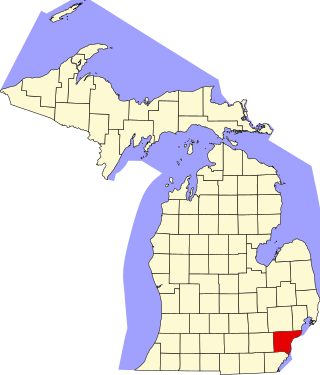
This is a list of the National Register of Historic Places listings in Wayne County, Michigan.

The Grosse Ile Toll Bridge is a swing bridge that crosses the Trenton Channel of the Detroit River connecting Grosse Ile Township, Michigan to the mainland in Riverview, Michigan which is located in Wayne County, Michigan.

The Wayne County Bridge is a swing bridge that crosses the Trenton Channel in the Detroit River. Located in Wayne County, Michigan, it connects Grosse Ile Township to mainland Trenton and is one of two bridges connecting the island of Grosse Ile to the mainland — the other being the tolled Grosse Ile Toll Bridge to the north. Locally, it is also known as "The Free Bridge".

Mongaugon Township, is a former township of Wayne County in the U.S. state of Michigan. Quarries where gray limestone and celestine associated with calcite, fluorite, gypsum, epsomite, and rarely, sulfur were first worked by the French circa 1749. United States forces aided by Muskrat French defeated United Kingdom forces aided by Native Americans forces at the Battle of Monguagon during the War of 1812.

Sugar Island is a small island in the Detroit River between Grosse Ile and Boblo Island. Sugar Island is part of Grosse Ile Township, Wayne County, Michigan, United States, and lies about 0.5 miles (0.80 km) west of the border with Canada. Currently the island is uninhabited and was recently converted to a wildlife refuge by the US Fish and Wildlife service. The majority of the island is wooded and it is known for its white sandy beaches and easy access by boat.
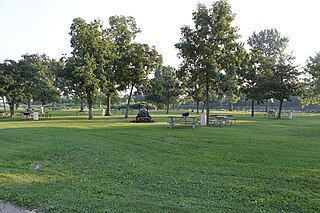
Lake Erie Metropark is a park in the Huron-Clinton system of metro parks. The park is a 1,607-acre (6.50 km2) recreational facility located between the mouth of the Huron River on Lake Erie to the south and the City of Gibraltar to the north, and consists of natural marshes and ponds, hike and bike trails, nature trails, a marina, and a boat launch. The park also has a wave action swimming pool, an 18-hole regulation golf course, and the Marshlands Museum and Nature Center. It has a three-mile (5 km) shoreline along Lake Erie and is a popular bird-watching site. The children's play area, located near the Wave Pool, previously consisted of a child-size city before being reconstructed into a modernized playground.

Grosse Ile is an American island in Wayne County in the U.S. state of Michigan. Located just west of the Canada–United States border in the Detroit River, it is the largest island in the river and the most-populated island in the state of Michigan. The island is administered by Grosse Ile Township.

The Trenton Channel Power Plant, also known as the Trenton Stacks, was a coal-burning power station located in Trenton, Michigan. Completed in 1924, it is owned by Detroit Edison, a subsidiary of DTE Energy.
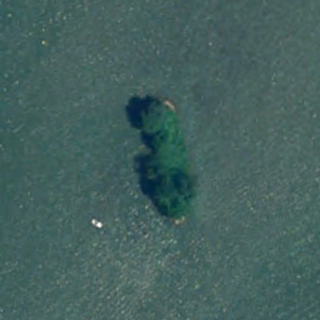
Powder House Island (also known as Dynamite Island) is an artificial island on the lower Detroit River in southeast Michigan, directly adjacent to the Canada–United States border. It was constructed in the late 1880s by the Dunbar & Sullivan Company to store explosives during their dredging of the Livingstone Channel, with the purpose of circumventing an 1880 court order forbidding the company to store explosives on nearby Fox Island.

Stony Island is an island in the Detroit River, in southeast Michigan. It has been used for hunting and fishing as long as humans have inhabited the region; from the mid-19th century to the mid-20th century, it was the site of a small settlement and served as a central location for the construction of the Livingstone Channel, as well as various civil engineering projects involving the Detroit River. By the 1990s, it had become completely uninhabited; it is now open to the public and administered by the Michigan Department of Natural Resources.




















